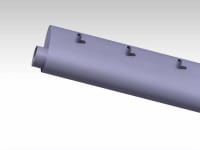On an average only 30% of the energy in the fuel supplied to an automobile engine is used to push the vehicle forward. A major portion of the rest of the energy, accounting to close to 60%, is either pumped out along with the exhaust gas or expelled through the radiator.
This work aims at optimizing the design of a heat recovery system for capturing that heat energy which is otherwise expelled into the atmosphere through the tail pipe, making it available to power the auxiliary systems like air conditioning system, lighting etc. Two major factors that has been optimized are heat transfer and reducing back pressure produced in the exhaust manifold due to the addition of the heat exchanger on the tail pipe. Different options were weighed to arrive at the final design.
• This is a shell and tube heat exchanger.
• We are using square pattern because of its low turbulence which avoids back pressure.
• Baffles are introduced in the design as it causes the fluid to flow through the shell at right angles to the axis of the tubes. They also help in increasing the length of flow of fluid and silencing the sound.
• The width of the shell and number of tubes vary from zero at the top and bottom to maxima at the centre of shell which causes a continuous change in the linear velocity of the fluid across the bundle.
• In this model flow of exhaust is through tubes and coolant through shell.
This device is adaptable to every four wheel vehicle and can be used for many purposes.
Like this entry?
-
About the Entrant
- Name:Manveen Kaur
- Type of entry:teamTeam members:Abhishek Behera
- Software used for this entry:solidworks
- Patent status:none





